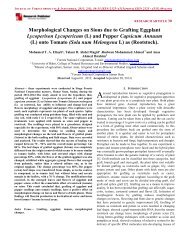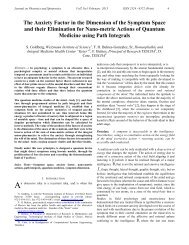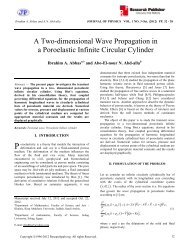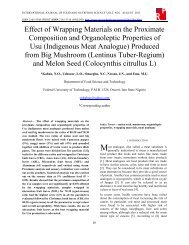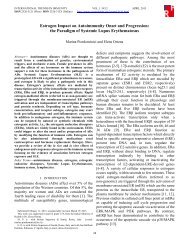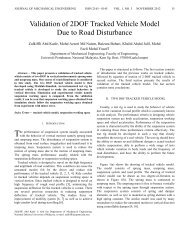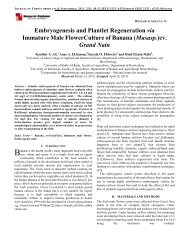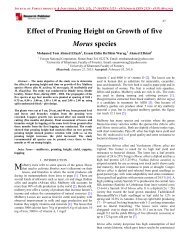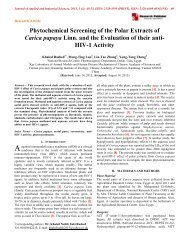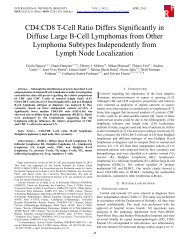(L) Seeds on Germination of Striga Hermonthica (Del.) Benth Seeds
(L) Seeds on Germination of Striga Hermonthica (Del.) Benth Seeds
(L) Seeds on Germination of Striga Hermonthica (Del.) Benth Seeds
You also want an ePaper? Increase the reach of your titles
YUMPU automatically turns print PDFs into web optimized ePapers that Google loves.
JOURNAL OF FOREST PRODUCTS & INDUSTRIES, 2013, 2(4), 16-21 ISSN:2325–4513(PRINT) ISSN 2325 - 453X (ONLINE)17Cement and other materialsPortland cement produced by Atbra cement Corporati<strong>on</strong>, Sudanwas used as binding material for all experiments. Other materialused includes, calcium chloride CaCl 2 used as cement settingaccelerator. Sodium hydroxide NaOH used as pretreatmentsolvent and gypsum CaSO 4 .2H 2 O used as chemical additives.Methodsvsome <strong>of</strong> the promising results obtained in the first threeexperiments will be used in the latter <strong>on</strong>e. These experimentsare, determinati<strong>on</strong> <strong>of</strong> extractive c<strong>on</strong>tent <strong>of</strong> mesquite wood(extractives solubility) using cold water, hot water and mildalkali extracti<strong>on</strong> methods following ASTM standard, 1981 (D1110-56)[13], selecti<strong>on</strong> <strong>of</strong> the best pretreatment/s to be appliedto mesquite wood to improve its compatibility with ordinaryPortland cement (soaking in water, soaking in sodiumhydroxide soluti<strong>on</strong>, additi<strong>on</strong> <strong>of</strong> calcium chloride and additi<strong>on</strong> <strong>of</strong>gypsum); investigati<strong>on</strong> <strong>of</strong> the effect <strong>of</strong> cement/wood ratios (2:1,3:1, 4:1 and 5:1) <strong>on</strong> the properties <strong>of</strong> mesquite wood cementaggregates and studying the effect <strong>of</strong> cement partial replacementby gypsum when low cement wood ratio (3:1) was used.The effect <strong>of</strong> Extracti<strong>on</strong> methods <strong>on</strong> mesquite wood extractivec<strong>on</strong>tentCold water extracti<strong>on</strong>Two grams <strong>of</strong> milled oven dry wood were soaked into 300 ml <strong>of</strong>distilled water and left for 48 hours at room temperature, thesoluble porti<strong>on</strong> was filtered, and then the residues were washedwith distilled water and dried into an oven at 105ºC. Dryingprocess was c<strong>on</strong>tinued until c<strong>on</strong>stant weight was obtained, thenthe extractive c<strong>on</strong>tent was calculated based <strong>on</strong> the initial sampleweight.Hot water extracti<strong>on</strong>Two grams <strong>of</strong> (oven dry) milled sieved wood were soaked into100 ml <strong>of</strong> hot distilled water and maintained at 70ºC in waterbath for three hours, then the sample was treated as in cold waterextracti<strong>on</strong>.Mild alkali extracti<strong>on</strong>sTwo c<strong>on</strong>centrati<strong>on</strong>s <strong>of</strong> Sodium hydroxide soluti<strong>on</strong> wereprepared, (namely 0.5% and 1%) and used as extracti<strong>on</strong> agent.Two grams <strong>of</strong> milled sieved wood were soaked in 100 ml <strong>of</strong>0.5% sodium hydroxide soluti<strong>on</strong> and maintained in a water bathat 97-100ºC for <strong>on</strong>e hour, and then the sample was treated as incold water treatment.Effect <strong>of</strong> pretreatments applied to mesquite woodThe pretreatments used for mesquite wood to improve itscompatibility with Portland cement were, soaking in cold water,additi<strong>on</strong> <strong>of</strong> calcium chloride, soaking in 1% sodium hydroxideand additi<strong>on</strong> <strong>of</strong> gypsum.Soaking in cold waterFor cold water treatment wood particles were soaked in tapwater for two weeks. Every two days, water was replaced byclean water to remove water soluble extractive that dissolved,and then the wood particles were air dried for <strong>on</strong>e week. Using afixed cement wood ratio <strong>of</strong> 2:1 and the appropriate amount <strong>of</strong>water, a mixture <strong>of</strong> wood, cement and water was prepared fromwhich five experimental specimens were produced. Theappropriate amount <strong>of</strong> water was calculated according to thefollowing equati<strong>on</strong>:[6]W= 0.35C+ (0.3-MC) ×W oWhereW: water/LC: Cement weighs KgW o : Oven dry weigh <strong>of</strong> wood KgMC: Moisture c<strong>on</strong>tent <strong>of</strong> woodThe specimens were prepared using metallic mould <strong>of</strong> 7×7×7cm.Then the specimens were left for 24 hours for cement setting,and the metallic mould was removed from the specimens afterwhich the specimens were soaked in water for 28 days in orderto allow complete curing <strong>of</strong> cement.Soaking in sodium hydroxide soluti<strong>on</strong>The wood particles were soaked in 1% sodium hydroxidesoluti<strong>on</strong> for 24 hours, and then the particles were washed severaltimes with tap water to remove the sodium hydroxide andextractive. They were left to air dry after that five specimenswere prepared using the same method described in the previoussecti<strong>on</strong>.Additi<strong>on</strong> <strong>of</strong> Calcium chloride (CaCl 2 )Based <strong>on</strong> cement weight 3% <strong>of</strong> calcium chloride was added tothe wood, cement and water mixture. Five specimens wereprepared from this mixture in the same way as in the precedingsecti<strong>on</strong>s.Additi<strong>on</strong> <strong>of</strong> GypsumBased <strong>on</strong> cement weight 20% <strong>of</strong> commercial gypsum was addedto the mesquite wood cement mixture and then the experimentproceeded as in the cold water treatment to produce fiveexperimental units.C<strong>on</strong>trolUntreated wood from Prosopis chillensis (mesquite) was mixedwith cement using the same ratio as c<strong>on</strong>trol to compare theabove menti<strong>on</strong>ed pretreatments. Five specimens were producedusing the same method as that used for cold water treatment.The effect <strong>of</strong> cement/wood ratios <strong>on</strong> the properties <strong>of</strong>mesquite wood cement aggregatesUsing Completely Randomized Design (CRD) with fivereplicates. Four cement wood ratios namely 2:1, 3:1, 4:1 and 5:1were used. Wood particles were mixed with Portland cementwithout any treatment or additives, the required amount <strong>of</strong> waterwas added, then the mixture was molded into testing metallicmold <strong>of</strong> (7×7×7 cm) and left for 24 hours for setting. Then theresulting cubes were soaked in water for four weeks forcomplete cement curing.



